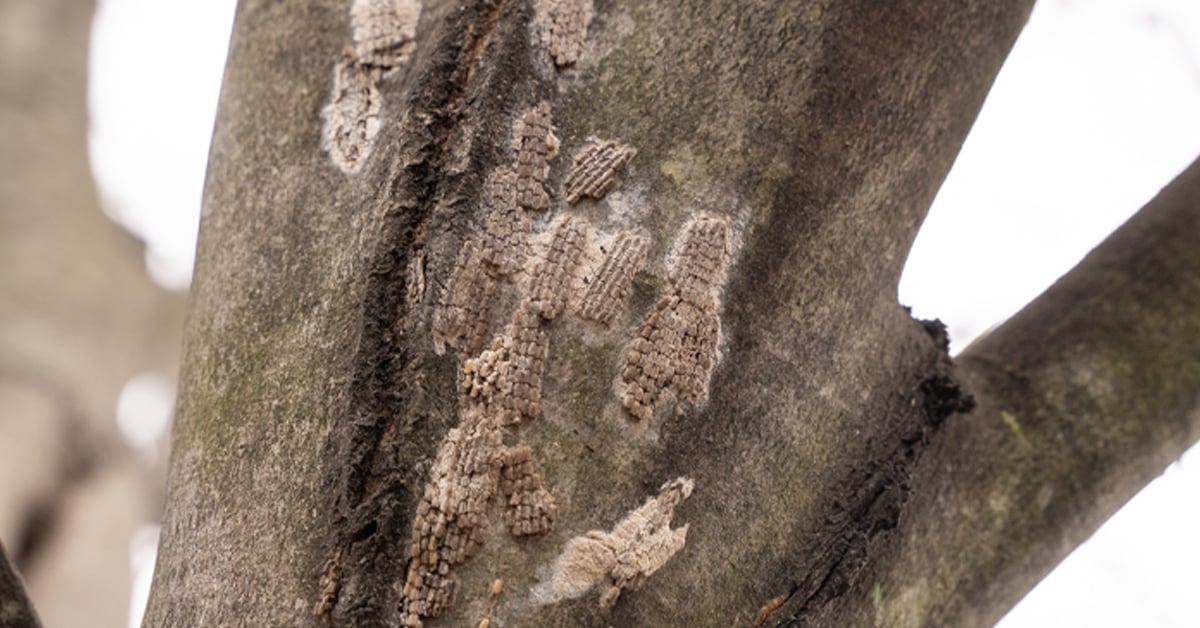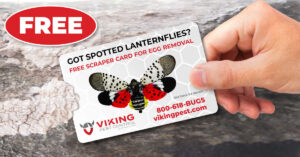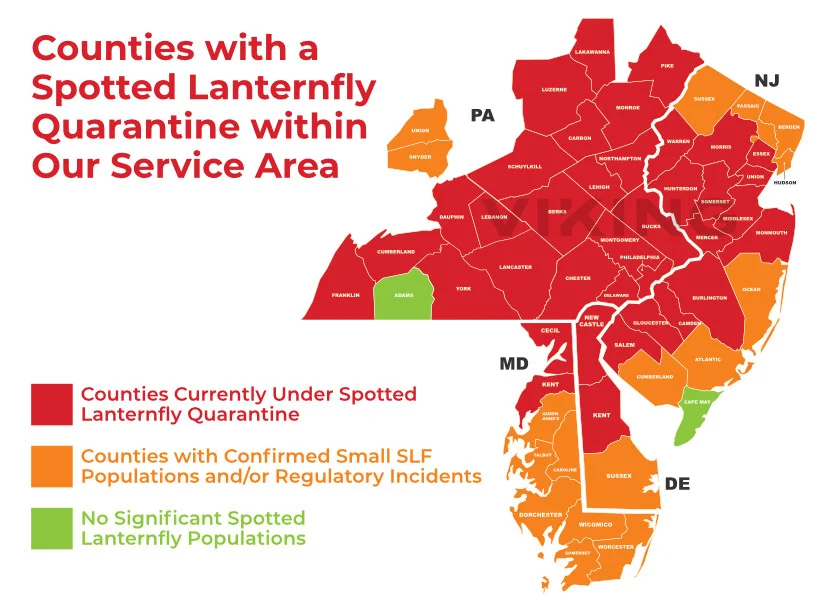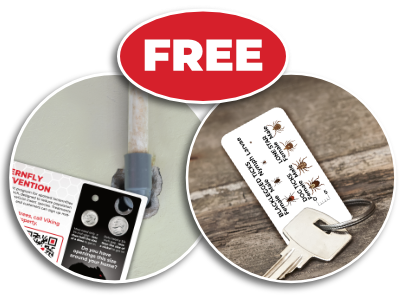To help stop this invasive pest spread, Viking Pest will mail you a FREE Spotted Lanternfly Egg Remover. Complete the form on this page, and a Spotted Lanternfly egg remover will be sent to you. In addition to egg removal, our revised card, first introduced in 2023, includes a keychain tag that shows the actual size and appearance of ticks found in PA, NJ, DE, and the Eastern Shore of Maryland, and holes that show the size of the gaps mice and rats can squeeze through to enter your home.
The revised complementary Spotted Lanternfly Removal card now includes keychain hangers that provide information about ticks found in Viking’s service area and holes demonstrating the smallest spaces necessary for mice and rats to enter a property. This measuring tool allows homeowners to quickly and easily measure existing interior and exterior gaps that can allow rodents a clear entry point.
Read below for tips for proper Spotted Lanternfly egg removal.
What are Spotted Lanternflies?
Spotted Lanternflies were first spotted in the United States in 2014 in Pennsylvania. Since 2014, they have spread to more than seven states, including New Jersey, Delaware, and Maryland. Spotted Lanternflies are an invasive species having the potential to cause devastating damage to vegetation and agricultural businesses. Spotted Lanternflies feed on most plant species and affect industries like vineyards, timber, and other farms. The Pennsylvania Department of Agriculture and the New Jersey Department of Agriculture has issued a quarantine for counties with Spotted Lanternfly sightings. Stopping the spread of Spotted Lanternflies is essential to protecting agriculture in the United States.
September is when Spotted Lanternflies begin laying their eggs, and Spotted Lanternflies can breed in vast numbers. Recognizing their egg masses and eradicating them will help immensely in controlling the spread of these invasive pests.
What Do Spotted Lanternfly Eggs Look Like?
The size of the mass can vary, but a Spotted Lanternfly egg mass is typically about an inch long by 3/4 of an inch wide and look like light grayish splotches of mud or mortar/cement. On some surfaces, there can be multiple egg masses.
Where Do Spotted Lanternflies Lay Their Eggs?
Spotted Lanternflies lay their eggs on trees mainly on the underside of branches but can also be found on man-made surfaces such as decking, brick structures, and sometimes cars.
How to Get Rid of Spotted Lanternfly Eggs
If you see a grown spotted lanternfly you should stomp on it. However, the most effective way to prevent spotted lanternflies is to eliminate their eggs. If you notice Spotted Lanternfly eggs, it is important to remove the eggs or call your local Department of Agriculture to report your findings. To remove Spotted Lanternfly eggs yourself, complete the form on this page, and we will mail you a FREE Spotted Lanternfly Egg remover. Read below for a few tips for DIY egg removal:
- Use your FREE Viking Pest Control Spotted Lanternfly Egg Scrapper
- Place the eggs into a plastic bag with hand sanitizer or alcohol
- Eggs should be scrapped off and removed from structures prior to their hatching in spring (May/June) to reduce the spread of this invasive pest.
- Click here to watch a video to learn how to remove Spotted Lanternfly Eggs properly
The Spotted Lanternfly Removal card now includes openings to demonstrate the size opening rodents need to gain entry to a home, along with information on the size and appearance of different types of ticks on a keychain tag.
Spotted Lanternfly Control for Commercial Properties
Because spotted lanternflies feed on the sap of plants, they can suck the life out of crops.
Besides depleting plants of their sap, they also excrete the sap back out. This excretion is sugary and sticky and attracts other insects such as ants. It creates a thick covering over plants. The excretions can also cause black mold to develop.
Spotted lanternflies target most fruit trees and are particularly drawn to grapevines. They also feed on hops plants and target timber trees as well.
This means that if you are a fruit, hops, or timber farmer, your harvests are particularly at risk.
If you are a cattle farmer, you might be wondering, can the spotted lanternfly harm my livestock?
The answer to this is yes, but not directly.
Spotted lanternflies feed strictly on plant sap and are not known to bite humans or animals. However, they may be destructive to fodder crops you have planted for your cattle herds.
For example, spotted lanternflies have been found feeding on alfalfa crops.
Spotted lanternflies often destroy plants and crops completely by weakening them to the point where they cannot recover. For some plants and trees, spotted lanternfly infestations are not fatal. However, their impacts usually significantly decrease plant yields.
If you need spotted lanternfly extermination carried out on your farm or commercial property, take a look at our spotted lanternfly control and prevention services. With over 40 years of experience in the industry, Viking Pest Control is the best choice in pest management services. As a certified member of QualityPro, we pride ourselves on providing cutting-edge treatments and superior customer service.
Our treatments are tailored to the unique needs of your commercial property. We provide free site evaluations with estimates of charges and hassle-free service scheduling and payment methods.














